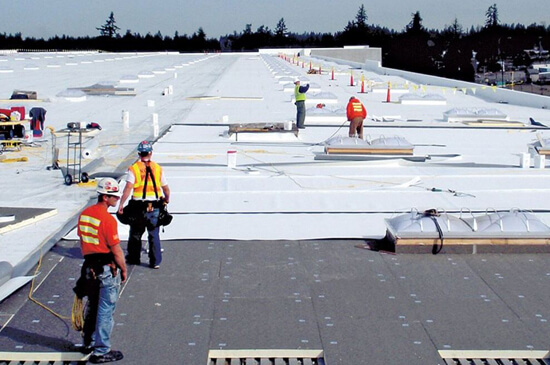Commercial flat roofing has become popular for many commercial buildings due to its practicality and versatility. However, like any roofing system, it has its advantages and disadvantages. In this blog, we will explore the pros and cons of commercial flat roofing to help you determine if it’s the right choice for your building.
Advantages of Commercial Flat Roofing: A Practical Choice
Commercial flat roofing offers several advantages that make it an attractive option for many property owners:
- Cost-Effectiveness: Flat roofs typically require fewer materials and labor during installation, making them more cost-effective than sloped roofs.
- Versatility: Flat roofing allows for installing HVAC units, solar panels, and other equipment, making it ideal for commercial properties with unique needs.
- Usable Space: Flat roofs can serve as additional space, such as rooftop gardens, recreational areas, or outdoor storage.
- Easy Maintenance: With a flat surface, inspecting and maintaining commercial flat roofing is generally easier and more accessible.
- Energy Efficiency: Flat roofs can accommodate cool roofing materials, reflective coatings, and insulation, improving energy efficiency.
Disadvantages of Commercial Flat Roofing: Addressing Potential Challenges
While commercial flat roofing offers several benefits, it also comes with some challenges:
- Drainage Issues: Flat roofs can experience drainage problems if not properly designed or maintained, leading to ponding water and potential leaks.
- Limited Aesthetics: Sloped roofs often offer more architectural design options, whereas flat roofs may be perceived as less visually appealing.
- Vulnerability to Damage: Flat roofs can be more vulnerable to certain types of damage, such as punctures from foot traffic or debris.
- Repairs and Maintenance: While maintenance is generally easier, repairs on flat roofing can be more complex due to locating and addressing leaks.
- Snow Buildup: Flat roofs may require additional measures to prevent snow buildup and potential structural issues in areas with heavy snowfall.
Considerations For Your Building: Assessing Your Needs
Before deciding on commercial flat roofing for your building, consider the following factors:
- Building Use: Assess whether the building’s function aligns with the advantages of flat roofing, such as rooftop access or equipment installation.
- Climate: Consider your region’s climate and weather conditions. Proper drainage and insulation are essential for regions with heavy rainfall or extreme temperatures.
- Budget: Evaluate your budget and compare the upfront costs and long-term savings associated with roofing options.
- Maintenance Plan: Determine if you have the resources and capacity for regular maintenance to prevent and address potential issues promptly.
- Future Plans: Consider future expansions or changes to your building that may impact the suitability of flat roofing.
Commercial flat roofing offers several practical advantages, including cost-effectiveness, versatility, and potential usable space. However, it’s essential to address potential challenges, such as drainage issues and vulnerability to damage. Assessing your building’s needs, climate, budget, and long-term maintenance plan will help determine if commercial flat roofing is the right choice for your property. Consulting with a professional roofing contractor can provide valuable insights and guidance in making an informed decision that ensures the durability and performance of your commercial roofing system.


